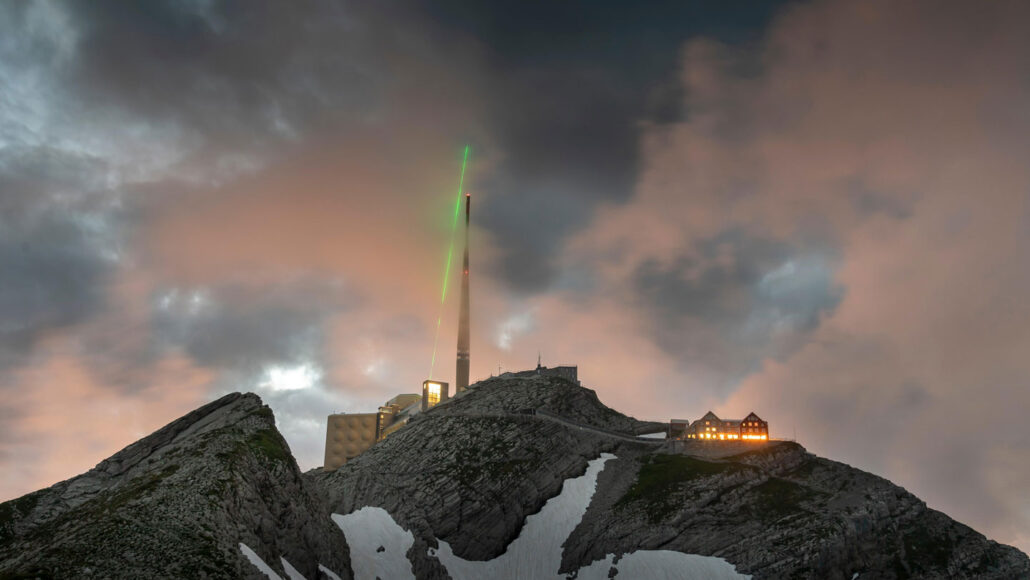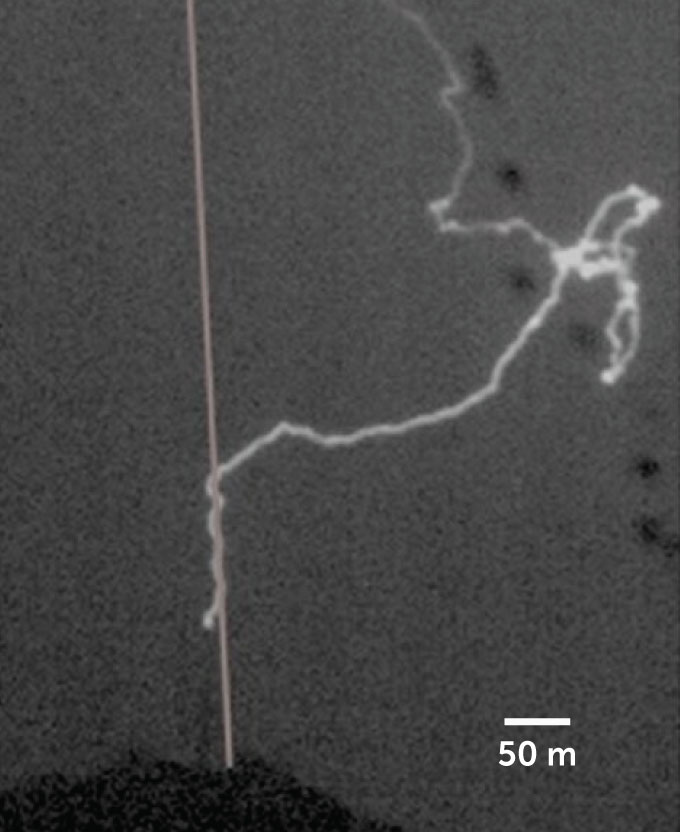A powerful laser can control the paths that lightning takes
This technology might someday improve lightning protection

Atop a mountain in Switzerland, researchers installed a powerful infrared laser to catch lightning beside a tower with a lightning rod (pictured). The green laser in this photo was used to mark the path of the infrared laser.
TRUMPF, Martin Stollberg
Like a high-tech hammer of Thor, a powerful laser can grab hold of a lightning bolt and reroute its path through the sky.
Scientists have used lasers to wrangle electricity in the lab before. But researchers now offer the first proof that this can also work in real-world storms. Their tests took place on a Swiss mountaintop. Someday, they say, it could lead to better protection against lightning.
The most common anti-lightning tech is the lightning rod: a metal pole rooted to the ground. Because metal conducts electricity, it lures in lightning that might otherwise strike nearby buildings or people. The rod can then safely feed that electricity into the ground. But the area shielded by a lightning rod is limited by the rod’s height.

Educators and Parents, Sign Up for The Cheat Sheet
Weekly updates to help you use Science News Explores in the learning environment
Thank you for signing up!
There was a problem signing you up.
“If you want to protect some large infrastructure, like an airport or a launching pad for rockets or a wind farm … then you would need, for good protection, a lightning rod of kilometer size, or hundreds of meters,” says Aurélien Houard. A physicist, he works at Institut Polytechnique de Paris. He’s based in Palaiseau, France.
Building a metal rod a kilometer (or mile) high would be tough. But a laser could reach that far. It could snag distant lightning bolts out of the sky and guide them down to ground-based metal rods. In the summer of 2021, Houard was part of a team that tested this idea atop the Säntis mountain in Switzerland.
A laser lightning rod
The team set up a high-power laser near a tower used for telecommunications. That tower is tipped by a lightning rod that is struck by lightning some 100 times per year. The laser was beamed at the sky during thunderstorms for a total of about six hours.

The laser blasted intense bursts of infrared light at the clouds 1,000 times per second. The train of light pulses ripped electrons off air molecules. It also knocked some air molecules out of its way. This carved out a channel of low-density, charged plasma. Think of it like clearing a path through the woods and laying down pavement. The combo of effects made it easy for electric current to flow along the laser’s beam. This created a path of least resistance for lightning through the sky.
Houard’s team tuned their laser so that it formed this electrically conductive path just above the tip of the tower. That allowed the tower’s lightning rod to catch a bolt snagged by the laser before it could zip all the way down to the laser equipment.
The tower was hit by lightning four times while the laser was on. One of those strikes happened in a fairly clear sky. As a result, two high-speed cameras were able to capture the event. Those images showed lightning zigzagging down from the clouds and following the laser for some 50 meters (160 feet) toward the tower.
The researchers also wanted to track the paths of three bolts they did not catch on camera. To do this, they looked at radio waves that were given off by the lightning strikes. Those waves showed that those three bolts also closely followed the path of the laser. The researchers shared their findings January 16 in Nature Photonics.
Real-world weather control?
This experiment “is a real achievement,” says Howard Milchberg. He’s a physicist at the University of Maryland in College Park who wasn’t involved in the work. “People have been trying to do this for many years.”
The main goal in bending lightning is to help protect against it, Milchberg says. But if scientists ever got really good at pulling lightning bolts out of the sky, there might be other uses, too. “It could potentially even be useful for charging things up,” he says. Imagine that: plugging into a thunderstorm like a battery.
Robert Holzworth is more cautious about imagining future control over lightning storms. He’s an atmospheric and space scientist at the University of Washington in Seattle. In this experiment, “they’ve only showed 50 meters of [guiding] length,” he notes. “And most lightning channels are kilometers long.” So, scaling the laser system up to have a useful, kilometers-long reach may take a lot of work.
That would require a higher-energy laser, Houard notes. “This is a first step,” he says, toward a kilometer-long lightning rod.
@sciencenewsofficial Powerful lasers can control what path lightning bolts take through the sky. #lasers #lightning #science #physics #learnitontiktok
♬ original sound – sciencenewsofficial







